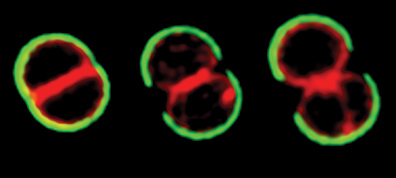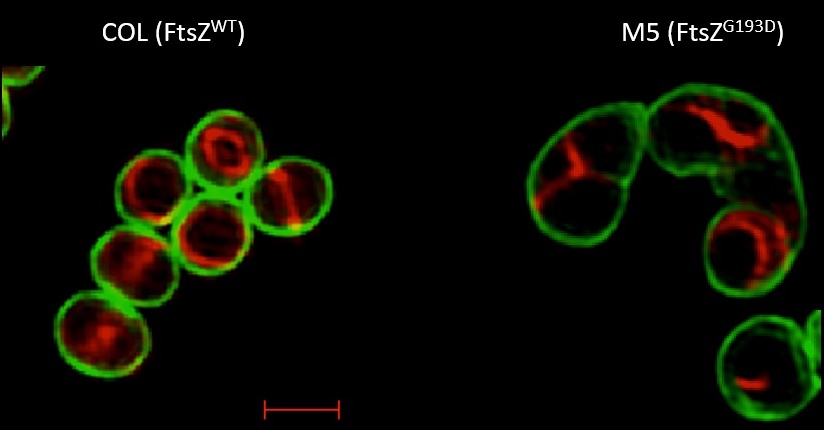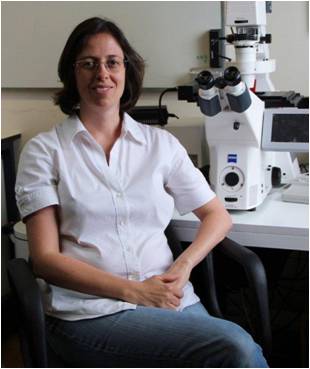How do bacteria get in shape?
Oeiras, 6.09.2016
Why are there spherical bacteria? Cocci seem to lack an elongation machinery that rods have developed, and the transition from a sphere to a rod-like shape has never been observed in bacteria, so it was thought that it couldn’t occur – up until now.
The most recent findings from Mariana Gomes de Pinho lab and collaborators have shown that Staphylococcus aureus can be forced to elongate their round shape if they acquire a single point mutation in the FtsZ protein, the bacterial tubulin homologue. The results were published today in mBio, American Society for Microbiology open access journal.
These findings are the result of the continuous work of the Bacterial Cell Biology Lab in understanding cell division in Staphylococcus aureus.
In 2015, the group was able to determine that cocci slightly elongate before cell division, using super-resolution microscopy (a technique worth the Chemistry Nobel Prize in 2014). With this method, they were able to understand that Staphylococcus aureus cells divide by a different process than what was previously described, the results were published in Nature Communications.

Staphylococcus aureus division by Mariana Gomes de Pinho Lab, 2015
To understand if Staph cocci could elongate as far as a rod, the group used a bacterial mutant previously isolated in 2012. At that time, they were collaborating with the company Merck to study new antibiotics against methicillin-resistant Staphylococcus aureus that target FtsZ, a bacterial cytoskeleton protein essential for cell division. These studies showed that an FtsZ-specific inhibitor compound acts synergistically with beta-lactam antibiotics, results published in Science Translational Medicine.
More recently, while studying S. aureus mutants resistant to the FtsZ-specific inhibitor compound, Ana Raquel Pereira, a PhD student at Bacterial Cell Biology Lab, serendipitously found that these mutants had an altered shape. For the first time a coccus elongating under the microscope was observed. In this paper, the authors present a novel FtsZ-dependent mechanism for the morphogenesis of elongated S. aureus cells.

Staphylococcus aureus: wild type, coccus, and mutant, rod shaped, by Mariana Gomes de Pinho Lab, 2016
“Phylogenetic analyses suggested that modern cocci may have evolved from rod-shaped bacteria by loss of an elongation machinery. Based on this, we and others have tried in the past to generate elongated cells from truly spherical cocci by expressing the cytoskeleton proteins that direct cell elongation in rods. However, this strategy failed, and in fact there are no reports of a coccus-to-rod transition, prompting the hypothesis that the spherical shape may be an evolutionary dead-end in morphogenesis. ”, says main author Mariana Gomes de Pinho. “Our study demonstrates the remarkable plasticity of cell shape in bacteria, and elucidates a molecular mechanism that resulted, for the first time, in the elongation of a truly spherical bacteria.”
ORIGINAL ARTICLE
mBio 7(5):e00908-16. doi:10.1128/mBio.00908-16.
FtsZ-Dependent Elongation of a Coccoid Bacterium
Ana R. Pereira, Jen Hsin, Ewa Król, Andreia C. Tavares, Pierre Flores, Egbert Hoiczyk, Natalie Ng, Alex Dajkovic, Yves V. Brun, Michael S. VanNieuwenhze, Terry Roemer, Rut Carballido-Lopez, Dirk-Jan Scheffers, Kerwyn Casey Huang, Mariana G. Pinho
THE LAB AND THE PRINCIPLE INVESTIGATOR
 Mariana Gomes de Pinho coordinates Bacterial Cell Biology Lab since 2006. The lab aims to understand, at a molecular level, the organization and the temporal and spatial regulation of two fundamental steps of cell division - the segregation of the bacterial chromosome and the synthesis of the division septum, as well as to integrate this information for a better understanding of antibiotic resistance mechanisms in S. aureus.
Mariana Gomes de Pinho coordinates Bacterial Cell Biology Lab since 2006. The lab aims to understand, at a molecular level, the organization and the temporal and spatial regulation of two fundamental steps of cell division - the segregation of the bacterial chromosome and the synthesis of the division septum, as well as to integrate this information for a better understanding of antibiotic resistance mechanisms in S. aureus.
In 2012, Mariana Gomes de Pinho was awarded European Research Council Starting Grant. The 1,6 M€ funding is being invested in research on the internal organization of Staphylococcus aureus, particularly in how the different synthetic machineries involved in the construction of the bacterial surface find their proper localization, so that a correct surface is assembled, enabling bacteria to resist antibiotics and establish successful infections.
PREVIOUS ARTICLES
Nature Communications (2015) DOI: 10.1038/ncomms9055
Cell shape dynamics during the staphylococcal cell cycle
João M. Monteiro, Pedro B. Fernandes, Filipa Vaz, Ana R. Pereira, Andreia C. Tavares, Maria T. Ferreira, Pedro M. Pereira, Helena Veiga, Erkin Kuru, Michael VanNieuwenhze, Yves V. Brun, Sérgio R. Filipe, Mariana G. Pinho
Highlight on webpage: How do bacteria divide?, 17.08.2015
Sci Transl Med. 2012 Mar 21;4(126):126ra35. doi: 10.1126/scitranslmed.3003592.
Restoring methicillin-resistant Staphylococcus aureus susceptibility to β-lactam antibiotics
Christopher M. Tan, Alex G. Therien, Jun Lu, Sang H. Lee, Alexandre Caron, Charles J. Gill, Christian Lebeau-Jacob, Liliana Benton-Perdomo, João M. Monteiro, Pedro M. Pereira, Nathaniel L. Elsen, Jin Wu, Kathleen Deschamps, Mihai Petcu, Simon Wong, Etienne Daigneault, Susanne Kramer, Lianzhu Liang, Eugene Maxwell, David Claveau, John Vaillancourt, Kathryn Skorey, John Tam, Hao Wang, Timothy C. Meredith, Susan Sillaots, Lisa Wang-Jarantow, Yeeman Ramtohul, Eric Langlois, France Landry, John C. Reid, Gopal Parthasarathy, Sujata Sharma, Anastasia Baryshnikova, Kevin J. Lumb, Mariana G. Pinho, Stephen M. Soisson, Terry Roemer
On Social Media
Facebook, Twitter and Linkedin
In the news
- Como é que as bactérias se põem em forma?, Notícias do Nordeste, 7.09.2016
- Como é que as bactérias se põem em forma?, Elvas News, 7.09.2016
- Como é que as bactérias se põem em forma?, Jornal Aurinegra, 12.09.2016
-
As bactérias mudam de forma?, Ardinas 24, 15.09.2016







